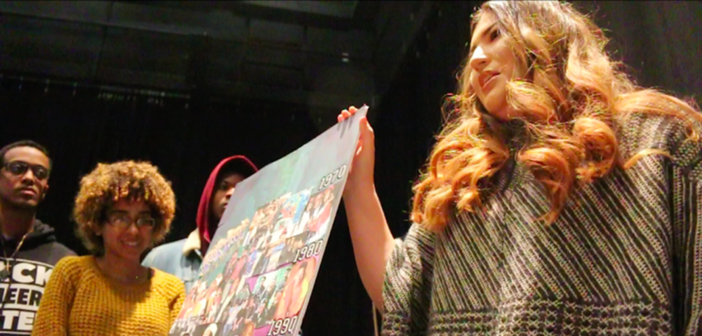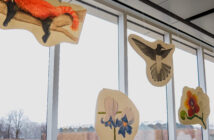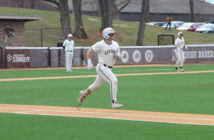Natalee Castillo, ’19, went on an eight-hour shopping spree at the King of Prussia Mall, all funded by Lehigh.
Castillo is the costume designer for the department of theatre’s upcoming show “Act Like You Know: 10-Year Anniversary Show.” Before going on the shopping trip with costume design professor Erica Hoelscher, Castillo spent hours planning, attending meetings and creating spreadsheets.
Castillo met with each of the show’s actors to learn about each individual’s style. She organized the information in a spreadsheet, developed designs and decided which materials to purchase.
Although Castillo’s designing for “Act Like You Know” is conducted outside the university’s theatre curriculum, students completed some of the costume construction in theatre courses.
“We try to keep the students as busy as possible, because the more you practice, the more familiar you become with (costume construction),” costume coordinator Pam Richey said.
Hoelscher said Costume Construction I and II are part of a larger curriculum. The department offers skill-based courses, which focus on technique as well as design, which is a more analytical side of the discipline that involves research and idea rendering.
Richey said Costume Construction I is a foundational course offered every semester. The two-credit course teaches the basics of sewing.
She said instruction is catered to the needs of beginners, regardless of students’ skill sets.
“The average student I get took that one middle school home (economics) class where they sewed a pillow and then hasn’t sewn since,” she said.
The advanced class, Costume Construction II, is only offered in the fall and requires instructor permission and completion of Costume Construction I. Richey said the course delves into patterning and advanced construction — students complete an entire project, while the coursework in the introductory class primarily focuses on partial garment completion and alterations.
Hoelscher said costume and fashion design is separate from the construction principles taught in the costume construction courses. Students take different paths to become costume designers.
Hoelscher is teaching introduction to fashion design this semester and will teach costume design in the fall. She said these courses are ways students can become involved with costume design.
The design class currently offered, introduction to fashion design, has an enrollment of 50 students.
“This semester, there are many students in intro to fashion design, so I tailored the syllabus for the class size,” Hoelscher said. “I wanted to give many students the opportunity to become familiar with design. Each course I teach is adjusted to meet the needs of enrolled students.”
She said introduction to fashion design is an entry-level course. Costume design draws on similar skills and projects but requires analysis and research.
Hoelscher said a costume designer has to interpret a script, video game outline, dance choreography, music or other type of prompt into a visual solution. She said design is a useful skill, regardless of a student’s major, because it demands problem solving.
“There are multiple potential solutions to a design problem, so a designer must also be able to present, explain, defend and troubleshoot their solution,” Hoelscher said. “These skills are applicable to any field.”
Castillo, a bioengineering student, said she sees the costuming design aspect of “starting from scratch” paralleled in her engineering studies.
“In my mechanics class, we get projects with little instruction about how to complete them,” she said. “You have to do your own background research and talk to sources, which relates to costume design because you’re responsible for reading the script, talking to mentors and generating your own concepts.”
Arianna Pineiro, ’20, who is also a bioengineering student and costume designer, said she also found similarities between the two disciplines. Pineiro said she had to troubleshoot in her work with a research lab this summer, similar to how she had to troubleshoot while completing the costume design for “Betrayal,” a Black Box production that ran from March 23-25.
She said the show required many quick changes, so the original designs she planned needed to be changed.
“I adapted for (the time constraints) and altered the way the quick changes were going to work,” she said.
Student designers will also design the costumes for three one-act student-directed plays in the “Familiar But Strange” performance. The show, consisting of plays, “How to Speak Man,” “The Zombies of Montrose” and “For the Living,” will be performed in Zoellner’s Black Box Theatre May 4-6.
Hoelscher said students learning design progress from smaller, more manageable projects to larger, more comprehensive ones.
Hoelscher said there really aren’t any “small projects,” however.
“The biggest shows I’ve ever done were musicals with over 100 costumes,” she said. “That was a lot of heavy lifting, but even on small shows you want the costumes to be relevant to the show and expose the theme to help the audience understand what is happening on stage.”
Pineiro said completing costume design for a show is a dynamic experience that changes from start to finish.
She said when she started to design for her show, nothing was concrete because the production had not yet been cast. The process developed as she met the actors, conducted fittings and finished alterations.
“Seeing your visions come to life on the stage is really really cool,” Pineiro said. “It’s a really great experience and I wouldn’t have had the experience if I hadn’t taken the costume construction class and absolutely fallen in love with it. It’s really rewarding.”






Comment policy
Comments posted to The Brown and White website are reviewed by a moderator before being approved. Incendiary speech or harassing language, including comments targeted at individuals, may be deemed unacceptable and not published. Spam and other soliciting will also be declined.
The Brown and White also reserves the right to not publish entirely anonymous comments.